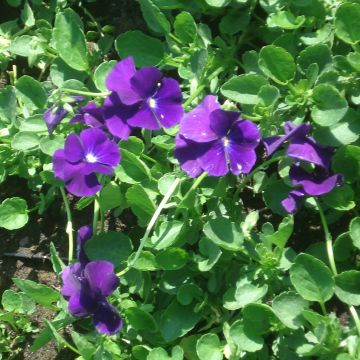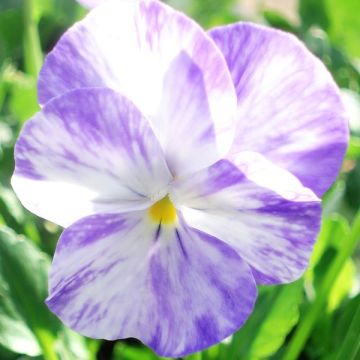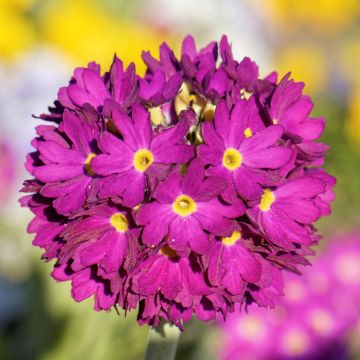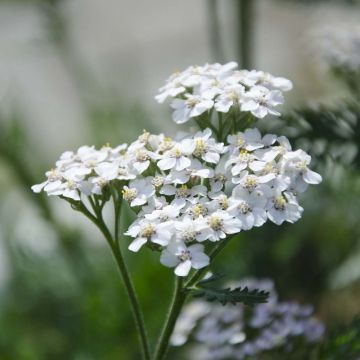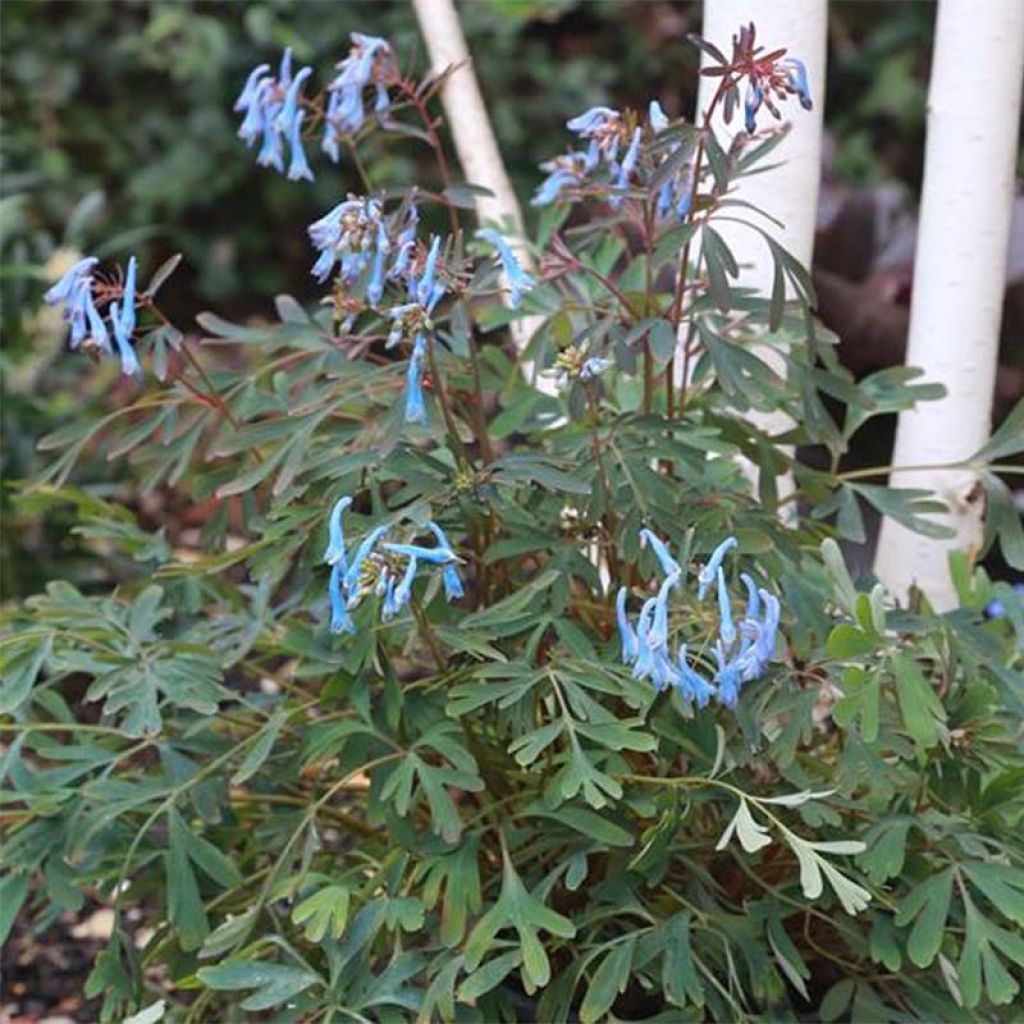

Corydalis flexuosa Porcelain Blue
Corydalis flexuosa Porcelain Blue
Corydalis flexuosa Porcelain Blue
Fumewort, Pseudofumaria, Capnoides
Superb! Received in excellent condition, already in bloom.
Gauthier, 18/07/2022
This item cannot be shipped to the selected country
Delivery charge from €5.90
Delivery charge from €5.90
More information
Schedule delivery date,
and select date in basket
This plant carries a 12 months recovery warranty
More information
We guarantee the quality of our plants for a full growing cycle, and will replace at our expense any plant that fails to recover under normal climatic and planting conditions.
From €5.90 for pickup delivery and €6.90 for home delivery
Express home delivery from €8.90.
From €5.90 for pickup delivery and €6.90 for home delivery
Express home delivery from €8.90.
Does this plant fit my garden?
Set up your Plantfit profile →
Description
The 'Porcelain Blue' Corydalis is an interesting new variety of Corydalis for its robustness, fragrant and well-flowering blue flowers, beautiful bronze-tinged foliage, and non-dormant growth in summer. In late spring and again in late summer or autumn, beautiful clusters of tubular flowers, pale and translucent, with a tendency towards turquoise, bloom above its finely cut foliage. It is a perennial plant of rare delicacy and relatively easy to grow in shaded and cool areas of the garden. It also thrives in flower pots on the terrace or balcony.
The 'Porcelain Blue' Corydalis belongs to the Fumariaceae family. It is a descendant of the Corydalis flexuosa recently obtained in England and presented at the Chelsea Flower Show in 2017. Its ancestor is native to the moist forests of western China. The moderately fast growth of this corydalis allows it to spread 30 cm (12in) in all directions in two years. This plant forms a compact and dense shrub and can spread as ground cover thanks to its stolons. The foliage, carried by reddish stems, has a fairly dark green colour mixed with bronze. Finely cut, it resembles that of bleeding hearts, ferns, or chervil. The flowering begins in May or June and ends around July. Then, it resumes in September-October and only stops with frost. In mild and humid climates, it is capable of flowering almost all year round. The flowers, similar to small tubes about 2.5 cm (1in) long, have a long spur. Each flower has areas that take on different shades of light blue. This elusive range of colours, painted on translucent petals, gives the flowering its unique turquoise and sky blue watercolour-like colour. This flowering exhales a sweet honey fragrance that attracts pollinating insects. The vegetation disappears in winter, depending on the climate.
The 'Porcelain Blue' Corydalis is a shade or semi-shade plant that thrives in humus-rich soil and expresses its full potential in a woodland setting, slowly forming large shrubs. It thrives in shade or semi-shade exposure in the morning sun, under trees or bushes without fearing competition as long as the soil remains moist. It forms beautiful borders along a path or a bed of perennials exposed to semi-shade. It can be paired with other perennials that appreciate the same environments, such as the cousin of Solomon's Seal (Uvularia grandiflora), hardy fuchsias, creeping bugle, Japanese anemones, bleeding hearts, tricyrtis, and a carpet of periwinkles. Plant this lovely variety in a pot on the terrace, in semi-shade, and don't forget to water it regularly. The plant tends to go dormant in summer and flowers again in autumn in warmer climates.
Report an error about the product description
Corydalis flexuosa Porcelain Blue in pictures


Flowering
Foliage
Plant habit
Botanical data
Corydalis
flexuosa
Porcelain Blue
Fumariaceae - Papaveraceae
Fumewort, Pseudofumaria, Capnoides
Cultivar or hybrid
Other Corydalis
Planting and care
Plant the 'Porcelain Blue' Corydalis in deep, light and humus-rich soil, always moist, neutral to acidic. It will thrive under shade or partial shade exposure in the morning sun, under trees or bushes, without fear of competition. Prune the plant in spring to remove dead foliage.
Planting period
Intended location
Care
-
, onOrder confirmed
Reply from on Promesse de fleurs
Spring flowering perennials
Haven't found what you were looking for?
Hardiness is the lowest winter temperature a plant can endure without suffering serious damage or even dying. However, hardiness is affected by location (a sheltered area, such as a patio), protection (winter cover) and soil type (hardiness is improved by well-drained soil).

Photo Sharing Terms & Conditions
In order to encourage gardeners to interact and share their experiences, Promesse de fleurs offers various media enabling content to be uploaded onto its Site - in particular via the ‘Photo sharing’ module.
The User agrees to refrain from:
- Posting any content that is illegal, prejudicial, insulting, racist, inciteful to hatred, revisionist, contrary to public decency, that infringes on privacy or on the privacy rights of third parties, in particular the publicity rights of persons and goods, intellectual property rights, or the right to privacy.
- Submitting content on behalf of a third party;
- Impersonate the identity of a third party and/or publish any personal information about a third party;
In general, the User undertakes to refrain from any unethical behaviour.
All Content (in particular text, comments, files, images, photos, videos, creative works, etc.), which may be subject to property or intellectual property rights, image or other private rights, shall remain the property of the User, subject to the limited rights granted by the terms of the licence granted by Promesse de fleurs as stated below. Users are at liberty to publish or not to publish such Content on the Site, notably via the ‘Photo Sharing’ facility, and accept that this Content shall be made public and freely accessible, notably on the Internet.
Users further acknowledge, undertake to have ,and guarantee that they hold all necessary rights and permissions to publish such material on the Site, in particular with regard to the legislation in force pertaining to any privacy, property, intellectual property, image, or contractual rights, or rights of any other nature. By publishing such Content on the Site, Users acknowledge accepting full liability as publishers of the Content within the meaning of the law, and grant Promesse de fleurs, free of charge, an inclusive, worldwide licence for the said Content for the entire duration of its publication, including all reproduction, representation, up/downloading, displaying, performing, transmission, and storage rights.
Users also grant permission for their name to be linked to the Content and accept that this link may not always be made available.
By engaging in posting material, Users consent to their Content becoming automatically accessible on the Internet, in particular on other sites and/or blogs and/or web pages of the Promesse de fleurs site, including in particular social pages and the Promesse de fleurs catalogue.
Users may secure the removal of entrusted content free of charge by issuing a simple request via our contact form.
The flowering period indicated on our website applies to countries and regions located in USDA zone 8 (France, the United Kingdom, Ireland, the Netherlands, etc.)
It will vary according to where you live:
- In zones 9 to 10 (Italy, Spain, Greece, etc.), flowering will occur about 2 to 4 weeks earlier.
- In zones 6 to 7 (Germany, Poland, Slovenia, and lower mountainous regions), flowering will be delayed by 2 to 3 weeks.
- In zone 5 (Central Europe, Scandinavia), blooming will be delayed by 3 to 5 weeks.
In temperate climates, pruning of spring-flowering shrubs (forsythia, spireas, etc.) should be done just after flowering.
Pruning of summer-flowering shrubs (Indian Lilac, Perovskia, etc.) can be done in winter or spring.
In cold regions as well as with frost-sensitive plants, avoid pruning too early when severe frosts may still occur.
The planting period indicated on our website applies to countries and regions located in USDA zone 8 (France, United Kingdom, Ireland, Netherlands).
It will vary according to where you live:
- In Mediterranean zones (Marseille, Madrid, Milan, etc.), autumn and winter are the best planting periods.
- In continental zones (Strasbourg, Munich, Vienna, etc.), delay planting by 2 to 3 weeks in spring and bring it forward by 2 to 4 weeks in autumn.
- In mountainous regions (the Alps, Pyrenees, Carpathians, etc.), it is best to plant in late spring (May-June) or late summer (August-September).
The harvesting period indicated on our website applies to countries and regions in USDA zone 8 (France, England, Ireland, the Netherlands).
In colder areas (Scandinavia, Poland, Austria...) fruit and vegetable harvests are likely to be delayed by 3-4 weeks.
In warmer areas (Italy, Spain, Greece, etc.), harvesting will probably take place earlier, depending on weather conditions.
The sowing periods indicated on our website apply to countries and regions within USDA Zone 8 (France, UK, Ireland, Netherlands).
In colder areas (Scandinavia, Poland, Austria...), delay any outdoor sowing by 3-4 weeks, or sow under glass.
In warmer climes (Italy, Spain, Greece, etc.), bring outdoor sowing forward by a few weeks.










































